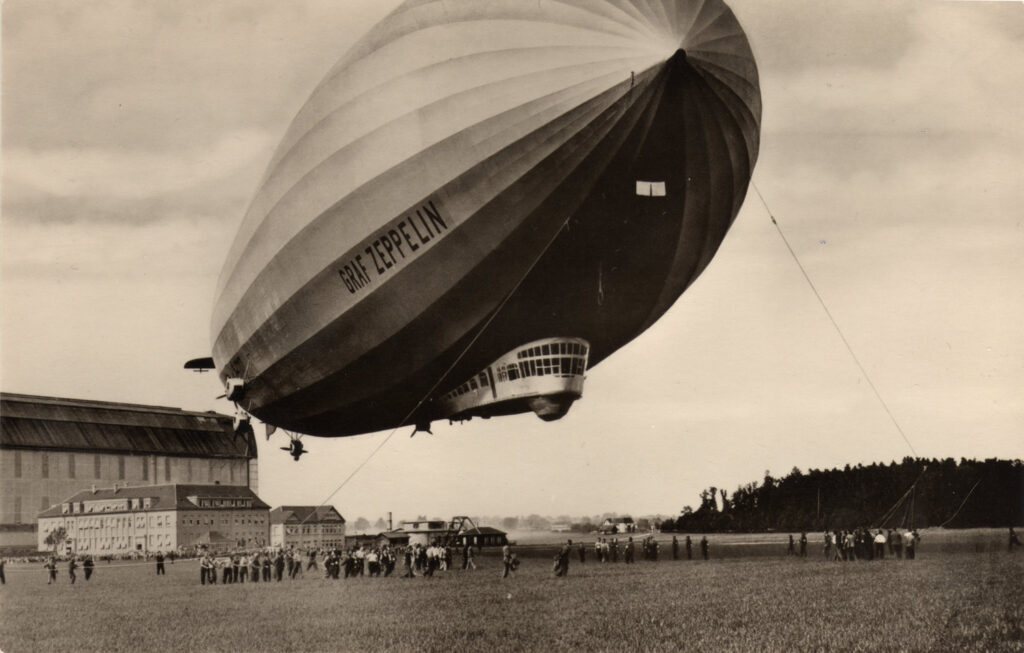You’ve heard of Zeppelins, the huge dirigibles that were the leading aviation machines until the Hindenberg disaster in 1937 convinced people that flying around underneath a large amount of hydrogen might not be the best idea. Oddly, although the photos are shocking, there were 97 people on board the craft and only 35 fatalities. Airliner crashes, many of which have claimed far more lives, have never had nearly the same effect as the Hindenberg; everybody keeps flying, but there hasn’t been a hydrogen-filled airship ever again. Even though quite a few more people died in a single airplane crash in Colombia in the very same year.
But we’re not here to talk about the Hindenberg specifically; today’s subject is Ferdinand von Zeppelin, who was born in Germany (or what is now Germany) on July 8, 1838. He was not an aeronautical engineer. He didn’t personally build airships. He didn’t even design them. He was, instead, a high-level military officer who came up with the idea of a rigid-framed airship, started a company to design and build them, and convinced the government to finance and use them. The idea of passenger service was actually Alfred Colsman’s idea.
Zeppelin wasn’t originally interested in flight at all; he was an army lieutenant who was sent to North America in 1863 to be an observer during the US Civil War. He was the guest of the Union Army. Balloons were used during that war as platforms for spotters to direct cannon fire, and Zeppelin happened to meet John Steiner in St. Paul, Minnesota. Steiner had also been born in Germany, and operated a balloon. As part of his duties as a military observer — or perhaps just as a personal favor from a fellow countryman — Steiner took Zeppelin up in his ballon. Zeppelin later said that experience gave him the idea of a kind of balloon that could be steered.
Zeppelin didn’t write his idea down until ten years later, in an entry in his personal diary. He’d been reminded of it by listening to a lecture about the notion of an airship designed to deliver mail. Then about ten years after that, the French army demonstrated a powered airship called La France. It was the first airship that could be fully controlled and steered. Zeppelin wrote a letter to his King about the military applications of airships, and pointed out that Germany was falling behind technologically. In the 1880s, France was the world leader in most technical areas.
Nothing happened for another ten years or so, when Zeppelin resigned from the Army (he was a General by then) and hired an engineer to turn his ideas into working designs. He was 52 when he finally started working on airships — but again, his role was more project director than inventor or designer. His organization submitted a design to the Prussian Airship Service, a military agency, but didn’t receive funding.
Zeppelin started funding airship development himself. In addition to being a military officer, he came from a family of German nobility, and was pretty wealthy. His company’s first airship flew in 1900, but was damaged when it landed. It had flown for 20 minutes, though, and that was enough to convince the King of Württemberg to contribute money. Prussia added some more, and Zeppelin’s second airship, LZ2, flew in 1906. It was not a success; the engines failed and although the LZ2 managed to land with only slight damage, there was a bad storm the next night and the craft was wrecked. The next airship, LZ3, did much better and in 1907 was flying around at the astonishing speed of 37mph.
On to LZ4, but that airship also encountered bad luck; a storm ripped it off its mooring and it was destroyed. Zeppelin concentrated on improving LZ3, and managed to convince an admiral and the Crown Prince to ride in a five-hour, 50 mile flight. Everything was looking up, until Zeppelin’s relationship with the military deteriorated. He blamed them for the loss of LZ2, and they didn’t take it well. But the public was enthused about airships, and the business director of Zeppelin’s company (Alfred Colsman, if you recall) said, in effect, “never mind military contracts, let’s carry passengers.” They did, and the service carried over 37,000 people on 1,600 flights by 1914. Then along came WWI, the military got interested again and Zeppelins were used as bombers. The company was shut down after the war, then restarted a few years later — but Count von Zeppelin didn’t live to see any of it. He died in 1917 before the war ended. But he’s remembered, not least whenever you listen to…Led Zeppelin! (Zeppelin’s granddaughter Countess von Zeppelin once threatened to sue the band for using the Zeppelin name, but evidently nothing came of it).

